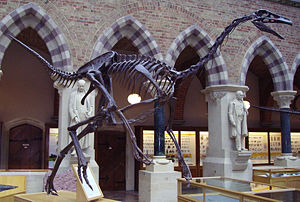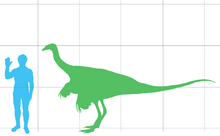Struthiomimus
| Struthiomimus | ||||||||||||
|---|---|---|---|---|---|---|---|---|---|---|---|---|

Skeletal reconstruction of Struthiomimus |
||||||||||||
| Temporal occurrence | ||||||||||||
| Upper Cretaceous (middle Campanium to early Maastrichtian ) | ||||||||||||
| 80.6 to 69.9 million years | ||||||||||||
| Locations | ||||||||||||
| Systematics | ||||||||||||
|
||||||||||||
| Scientific name | ||||||||||||
| Struthiomimus | ||||||||||||
| Osborn , 1917 |
Struthiomimus was a genus of dinosaurs from the group of Ornithomimosauria within the Theropoda . He lived in the late Upper Cretaceous in what is now North America.
features
Struthiomimus reached a length of around 4 meters and had the body structure typical of all Ornithomimidae . He moved biped (on his hind legs).
The head was relatively small and light. The elongated snout was completely toothless and ended in a horned beak. The big eyes sat on the side of the head. The neck was long and flexible. The forelimbs were relatively large, but weakly built. Struthiomimus differed from other Ornithomimidae by their very long hands - the hand was longer than the humerus or the skull. The hands ended in three fingers that had long but blunt claws. The hind legs were significantly longer than the front limbs. The relatively thin bones and elongated lower legs suggest that this dinosaur could run very fast. The metatarsals were also elongated, the feet ended in three toes pointing forward. The stiffened tail was probably used for balance.
What Struthiomimus ate on is not known. Investigations in other ornithomimosaurs revealed evidence of either a plant-based diet or a filtering uptake of small organisms from the water. The large hands with long claws could have been used to pull branches down to get to the leaves or fruit. An omnivorous diet is also conceivable.
Discovery and naming
The fossil remains of Struthiomimus were discovered in the Horseshoe Canyon Formation in the Canadian province of Alberta . Lawrence Lambe first described it in 1902 under the name Ornithomimus altus . In 1917 Henry Fairfield Osborn established the new genus Struthiomimus thanks to new, better-preserved finds . The name means ostrich imitates and alludes to the similarities between these animals and ratites.
The finds are dated to the late Upper Cretaceous (middle Campanian to early Maastrichtian ) to an age of around 80 to 69 million years.
literature
- Peter J. Makovicky , Yoshitsugu Kobayashi, Philip J. Currie : Ornithomimosauria. In: David B. Weishampel , Peter Dodson , Halszka Osmólska (eds.): The Dinosauria . 2nd edition. University of California Press, Berkeley CA et al. 2004, ISBN 0-520-24209-2 , pp. 137-150.
Web links
Individual evidence
- ^ Gregory S. Paul : The Princeton Field Guide To Dinosaurs. Princeton University Press, Princeton NJ et al. 2010, ISBN 978-0-691-13720-9 , pp. 115-117, online .

